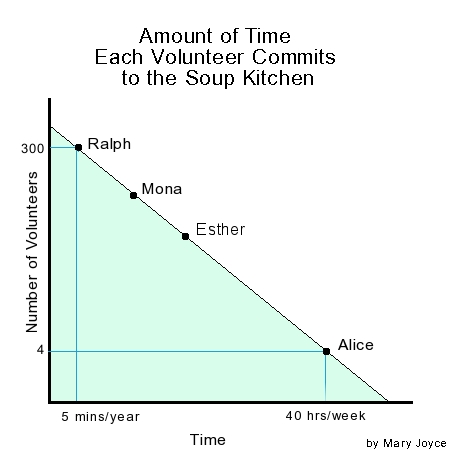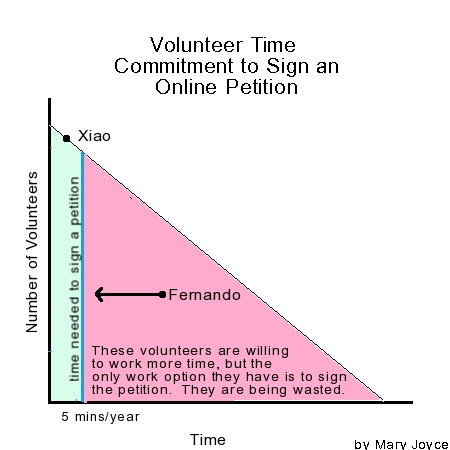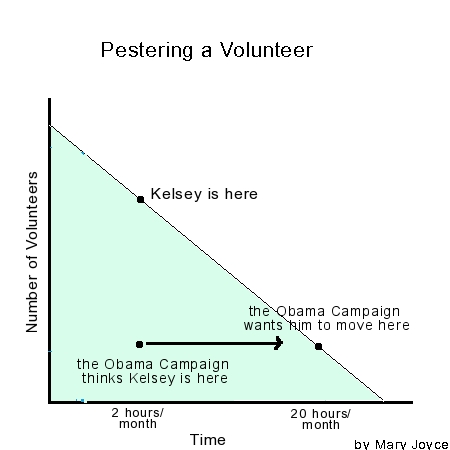Civic Engagement and the Internet: Online Volunteers
November 18th, 2007 — marycjoyceThe Internet assists social change campaigns by making participation easier. You don’t need to go to a particular location to volunteer or even write a check to donate. It’s just point and click, point and click. But by taking advantage of the online medium, many organizations are losing the benefit of the face-to.face campaign: getting the most out of each volunteer.
[Contents: An Offline Example: The Local Soup Kitchen / Applying These Lessons Online: Freeing a Blogger / How Small Campaigns Can Solve the Volunteer Utilization Problem / Solutions for Big Campaigns: Barack Obama’s Campaign for President / Pitfalls of the Strategy: Don’t Pester Your Volunteers ]
An Offline Example: The Local Soup Kitchen
In the good old days, people used to participate in local civic organizations. You would spend a Sunday at the soup kitchen, or Tuesdays and Thursdays at the Red Cross. These organizations understood how to get the most out of each volunteer because they knew each volunteer. Mona would come in twice a week for three hours to make meals at the soup kitchen. Esther also volunteered twice a week and was also a member of the Board of Directors. Alice, the Director, volunteers full-time for the organization. Ralph, on the other hand, gives a donation of $100 every year, but no more.
Each of these people was giving their maximum participation. This was achieved through constant communication between the Director of the soup kitchen and each volunteer. When Alice noticed that Esther was coming in every week to volunteer, she asked her if she wanted to take on some leadership responsibility by joining the Board of the Directors. Esther accepted. Alice asked the same question of Mona, who also volunteered weekly, but Mona said that with the responsibility of her other civic activities, she couldn’t give the time. Alice was able to get both Mona and Esther to give their maximum participation to the food bank.
How can we express the idea of different people giving their “maximum participation” to a civic organization or activist campaign? It is not as if there is one maximum. Esther’s maximum is volunteering and leadership. Mona’s maximum is just volunteering. Ralph’s maximum is writing a check once a year.
We can represent different levels of civic participation graphically:

In the graph above, the bottom axis measures the amount of time each volunteer commits to the soup kitchen. Ralph, who writes a check once a year, is at the far left with 5 minutes a year. Alice, who volunteers full-time at the soup kitchen is at the far right of the graph with 40 hours worked per week.
The lefthand axis is a little more complicated. It measures the amount of people that are willing to donate a particular amount of time. There are many more people like Ralph, who commits 5 minutes per year, than there are people like Alice who are willing to commit almost all their time to the soup kitchen. This graph estimates that, for a small organization like the soup kitchen, there are about 300 people like Ralph who donate a very small amount of time and about 4 people who are willing to devote a very large amount of time like Alice. Mona and Alice fall somewhere in the middle.
Another important thing to note is that everyone is giving their maximum amount of participation, because they are on the participation line, which marks the maximum time each individual is willing to give. If, for example, there are another volunteer, Tom, who was only donating 1 day per week but was actually willing to work 2 days per week, Alice should talk to him and convince him to work those two days in order to get the maximum amount of participation (the same amount of participation as Mona). The goal is for each volunteer to give the maximum time they are willing to give to the organization. 
Applying These Lessons Online: Freeing A Blogger
It is easy to lose the habit of effectively using volunteers when activities move online. The Internet is so appealing in part because it allows an organization to connect with volunteers from around the country (or around the world), greatly increasing their volunteer base. The problem is that most organizations never communicate with these volunteers and thus are unlikely to extract their maximum participation.
Let’s take an example of an online campaign to free an imprisoned blogger. Let us assume that this organization, which we’ll call BlogFreely, is asking people to sign an online petition which will be sent to the president on the imprisoned blogger’s country asking the president to free the blogger. By asking volunteers to sign a petition, they are asking all volunteers to commit 1 to 5 minutes of their time. The logic behind this is that people are busy and that you should give them an action that takes as little time as possible. Here’s what the graph looks like:

Here is the time commitment graph for signing an online petition, which takes 1 to 5 minutes, depending on whether or not you also leave a comment. Here, the blue section represents the volunteers willing to give 1 to 5 minutes to the campaign. They are giving their maximum amount of time to the campaign. Xiao is in this group. She in willing to give 4 minutes to the campaign and she fills out the petition in 4 minutes. The campaign has extracted all the participation time they can from her. There are lots of people like Xiao who are willing to give only a little bit of time. BlogFreely is using thesee volunteers well with their online petition campaign.
However, there are also volunteers like Fernando. Fernando is passionate about freedom expression. He is also a blogger, so he feels solidarity with the imprisoned blogger. He would love to give more time, maybe even a few hours a week. Unfortunately, BlogFreely gave Fernando no option to participate more. The most he can do is sign the petition. By not communicating with Fernando or giving him other options, BlogFreely is missing out on the productivity that Fernando coud bring to their campaign.
Volunteers like Fernando, in the pink region, are being wasted because they are willing to give more time to the campaign, but the campaign gives them no opportunity to donate this time.
How Small Campaigns Can Solve the Volunteer Utilization Problem
BlogFreely is a small campaign. They have no full-time staff and everyone who works for the campaign works as a part-time volunteer. They really need people like Fernando to increase their capacity to advocate for bloggers. First of all, they need to make themselves accessible to people who want to get involved. They need to put contact information on their web site clearly and encourage people to get involved at every opportunity. When a potential volunteer contacts them, they need to communicate with that person to determine the maximum amount of time that person will commit and then give that person the resources they need to be productive.
They might also consider putting multiple action options on their site. Such a strategy would graphically look like this:

BlogFreely has decided to change their strategy to better take advantage of their volunteers. They now offer four options of time commitment: sign the petition, tell a friend about the campaign, send a letter to the editor of your local paper, and become a member of the campaign team.
This strategy is not perfect because there is still not an option for everyone. For example. A person who is willing to devote 20 minutes to the campaign is willing to commit more than the 10 minutes needed to tell a friend but less than the 45 minutes needed to write a letter to the editor. This problem could be solved by talking to individual volunteer, but this is not practical for every campaign.
Solutions for Big Campaigns: Barack Obama’s Presidential Campaign
The option of speaking to every volunteer is particularly impractical for large campaigns, yet communication with high-producuing volunteers is still worthwhile, even for a big campaign. In this situation, it makes sense to devote communication time to top-producing volunteers. Obama for America offers a good example of this kind of strategy.
The Obama campaign gives people many opportunities to get involved, as is evident in its personalizable my.barackobama homepages. These pages allow you to find Obama supporters near you, plan an Obama event, become a fundraiser, and blog about Obama.

In addition to these means of getting involved online, some volunteers also get personal attention from the campaign staff. Because the campaign staff cannot communicate with the millions of Obama supporters around the country, they focus their human resources on top-producing volunteers. Volunteers who agree to be small-scale fundraisers get to speak on a regular basis with a member of the fundaising staff and a professional fundraiser via conference call. These calls help the campaign get the most out of these high-producing volunteers.
Pitfalls of the Strategy: Don’t Pester Your Volunteers
The strategy of getting the maximum time out of your volunteers is great, but you can go to far. By constantly demanding that volunteers give you more time – in an effort to extract their maximum participation – you may actually alienate your volunteers. This can cause them to give less time to the campaign than they were willing to give originally.
For example, my friend Kelsey signed up with the Obama campaign and got really involved. He donated $50, went to some Obama mixers, and attended an Obama rally in Boston.
Then the constant e-mails and junk mail began. Obama campaign members began calling him at work. It got really annoying. Kelsey still likes Obama but he is less enthusiastic because the campaign keeps pestering him.

Kelsey is happy commiting 2 hours to the campaign every month. This is his maximum participation time. However, the campaign is hoping that he is one of the few people committing 2 hours to the campaign that would actually be happy committing more time, say 20 hours a month. They keep trying to push him to spend more time on the campaign but this is actually alienating him. They have misperceived his maximum commitment and are now just pushing him away from the campaign, which is counter-productive to their goal.
The solution to this problem is not difficult. You need to listen to your volunteers. If you call a volunteers three time to ask them to spend more time on your campaign and every time they say “no,” that means that they are already giving their maximum time. Stop pestering them and just be thankful for the time that they are giving already.
The Internet gives social change organizations the opportunity to attract far more volunteers than geographically-based campaigns of the past. If we use the Internet to connect with more volunteers without losing the close communication of local campaigns, we will have the best of both worlds.
[this post is cross-posted on Mary’s blog, ZapBoom]






 Click Here
Click Here
November 19th, 2007 at 4:21 am
Hi Mary,
Guess you’ll find this article of mine (sorry for spamming…) of your interest:
http://ictlogy.net/bibciter/reports/projects.php?idp=612
Best,
Ismael.
November 19th, 2007 at 1:14 pm
Yes, there is definitely some overlap there.